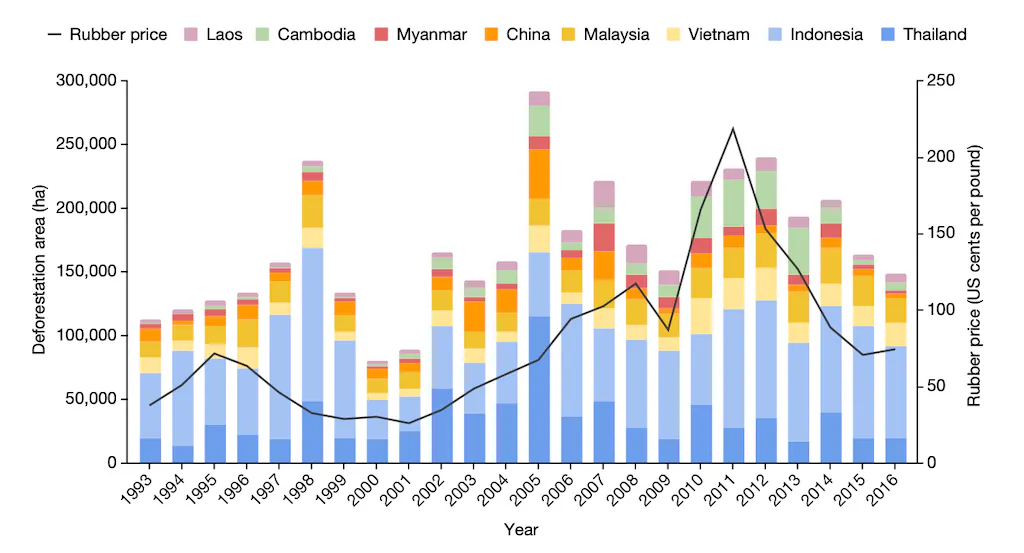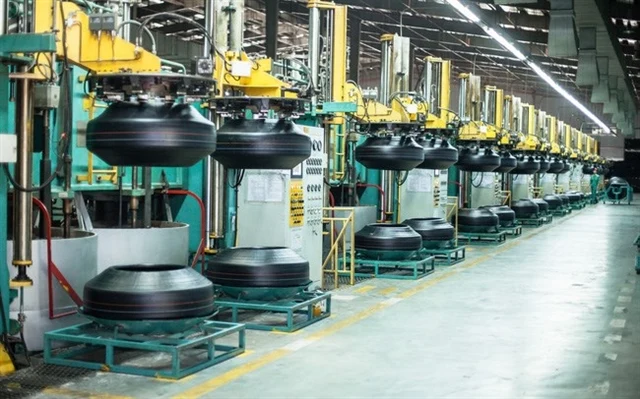Deforestation for rubber plantations, a previously under-recognized environmental issue, is proving more extensive and damaging than earlier thought. This article delves into the alarming rates of forest loss linked to the expanding rubber trade. We’ll explore how this trend not only threatens biodiversity but also has broader ecological impacts.
The Scale of Forest Loss
The deforestation for rubber plantations has reached an alarming scale, exceeding initial estimates significantly.
Over 4 million hectares, an area comparable to Switzerland, have been cleared since the 1990s. This massive loss of tree cover has been primarily in Southeast Asia, a region known for its rich biodiversity.
Recent research indicates that countries like Thailand, Indonesia, and Vietnam are among the most impacted by deforestation for rubber plantations. In Thailand alone, over 500,000 hectares have been converted into rubber plantations, significantly impacting local ecosystems.
Indonesia has faced a similar situation, with vast areas of its biodiverse rainforests being cleared. Notably, in the Vietnamese province of Dak Lak, satellite imagery revealed a 52% increase in rubber plantation area from 2000 to 2010, largely at the expense of native forests.

In fact, satellite images and ground reports have consistently shown that these plantations are often established at the expense of primary and secondary forests. This deforestation affects not only the ecological balance but also disrupts water cycles and local climate patterns, creating a broader environmental impact.
Increasing Demand and Its Implications
The surge in global demand for natural rubber, a key material in many industrial and consumer products, is a primary driver behind this extensive deforestation. Projections suggest the need for an additional 2.7 to 5.3 million hectares of plantation by 2030 to meet this growing demand.
Natural rubber is extensively used in the automotive industry, particularly for tire production. Companies like Goodyear and Michelin are major consumers of natural rubber. The aviation industry, including manufacturers like Boeing and Airbus, also relies heavily on natural rubber for various components.

This widespread industrial use is a significant driver behind the expansion of rubber plantations. The United States, as one of the largest consumers of rubber products, plays a key role in this demand.
Unfortunately, the expansion strategy predominantly involves clearing new areas rather than increasing productivity on existing plantations.
This approach significantly diminishes ecosystem services, such as carbon sequestration and biodiversity maintenance, underscoring the urgency for more sustainable agricultural practices in the rubber industry.
Rubber Production and Biodiversity Loss
The shift from diverse natural forests to monoculture rubber plantations has resulted in a significant decline in biodiversity. Studies indicate a noticeable reduction in species richness, particularly among forest-dependent species, within plantation areas.
The biodiversity loss is stark in countries with extensive rubber plantations. In Indonesia, for example, rubber plantation expansion has led to habitat loss for species like the Sumatran tiger and the Javan rhinoceros. Studies have shown that these monocultures support up to 60% fewer animal species compared to natural forests in the region. The loss of natural habitats is also affecting indigenous communities, who rely on these forests for their livelihoods and cultural practices.
The impact of this loss isn’t limited to flora and fauna but extends to the weakening of ecosystem resilience and function, which is vital for environmental health and stability.

Socio-Economic Implications and Regulatory Challenges
Rubber production is a complex issue intertwined with socio-economic challenges. While it supports millions of livelihoods, it often involves labor-intensive work, low wages, and exposure to harmful chemicals.
Smallholder farmers, the backbone of this industry, face numerous challenges, including market volatility and climate change impacts. New regulations aimed at reducing deforestation, such as the EU’s legislation, may inadvertently impact smallholder farmers who struggle to comply due to lack of resources and dependence on middlemen.
In terms of regulation, the governments of major rubber-producing countries, like the Indonesian and Thai governments, are implementing policies to balance economic growth with environmental conservation. However, these efforts often face challenges due to the complex supply chain and the involvement of multinational corporations. The European Union’s recent regulations aim to curb deforestation-linked imports, but there are concerns about their impact on smallholder farmers, who are a crucial part of the global rubber supply chain.
Potential Solutions and the Way Forward

To address these challenges, some companies are adopting sustainable rubber sourcing policies.
For example, Michelin has committed to 100% sustainable rubber by 2050 and is working with smallholder farmers to improve practices. Initiatives like the Sustainable Natural Rubber Initiative (SNR-i) and the Global Platform for Sustainable Natural Rubber (GPSNR) are also working towards more responsible rubber production practices. These efforts involve collaboration between governments, companies, and NGOs to create a more sustainable and equitable rubber industry.
Empowering smallholder farmers and implementing international collaboration and robust policy frameworks are essential steps towards a more sustainable and equitable rubber industry.
In conclusion, the impact of rubber plantation expansion on global forests is more severe than previously understood, with over 4 million hectares lost since the 1990s. This deforestation, driven by the escalating demand for natural rubber, isn’t just an environmental issue but also a socio-economic challenge. The loss of biodiverse forests to monoculture plantations significantly reduces species richness and ecosystem resilience, highlighting the urgent need for sustainable practices.
More To Discover
- Can There Be Sustainable Tropical Forest Harvesting? Yes! 5 Strategies To Get It Done
- Vanuatu Stops Chinese Logging Firm Amid Theft Claims and Workers In Chinese Military Uniforms
- Planting Trees in the Wrong Places Can Warm the Planet
- Earth’s Northern Crown At Risk: Our Largest Continuous Expanse of Wilderness Is Shrinking
Key takeaways from this article include:
- The scale of forest loss due to rubber plantations is alarmingly extensive.
- The increasing demand for natural rubber is leading to significant ecological consequences.
- A balanced approach involving agroforestry, synthetic rubber, and improved supply chain practices is crucial for sustainable rubber production.
As we move forward, it’s imperative to find a balance between the economic benefits of rubber production and environmental preservation. Innovative solutions like agroforestry, synthetic alternatives, and transparent supply chains can pave the way. Implementing robust policies and international collaboration will be key to ensuring the rubber industry’s transition to sustainability, benefiting both our planet and the communities that depend on it.



















